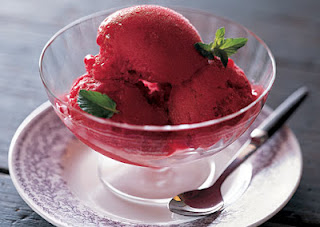Now that it's officially summer up here in the Northern Hemisphere, I thought it would be a good idea to present a seasonal update to our Kitchen Codex. Certain foods are inextricably linked, by social convention or personal preference, to the sun-filled, BBQ-laden nostalgic brilliance that is summer. Though the stereotype of a subterranean, seasonless existence holds true for some of us (I'm a redhead; UVA/B rays and I exist in mutual antagonism), even the most solar-adverse nerds have a favorite flavor of ice cream.
 |
| One of the best parts about being an adult: ice cream for dinner |
Fair question. Short answer: as with anything homemade, it's a matter of control over the finished product and exercising the predilections that shape said outcome. As mentioned before, we of the geeky persuasion often get thrown under the LAZY bus when it comes to the matter of feeding ourselves. This does not need to be the case, as we saw with the mini pie maker. Easier =/= Better.
However, I very much sympathized with the above skepticism as to whether actually making your own ice cream was a worthwhile venture. Floating somewhere in my temporal cortex is the memory of my mother attempting to make ice cream with an antique wooden drum, a hand crank, some cream and a smattering of rock salt. Attempting is an accurate verb, as this effort ended in creating little more than a salty, slushy mess. Similarly, a much more recent endeavor to make ice cream in one of these as a fireside diversion while on a camping trip produced inedible lactose mush and a cracked spherical plastic paper weight. Given this dubious track record, I was aporetic of the potential of the tidy appliance that I'd been gifted with and was ready to consign it to the Valley of Unloved Kitchen Electrics even before removing it from its box.
I was sorely, sorely mistaken.
 |
| Sorbet, a fun alternative for the lactose intolerant |
Seriously? Seriously.
Akin to the mini-pie maker, the amount of prep time required and degree of difficulty associated with using the ice cream maker is highly dependant on what you'd like to accomplish. Ostensibly, single flavors without additives are almost always simpler and quicker to make than something like Toasted Almond with Coconut or an ice cream that features all the marshmallows you'd find in a box of Lucky Charms.
Ok, this sounds great and all…but what do I look for in an ice cream maker?
There are a few different base models of ice cream maker currently available for retail: manual, freestanding electric, and attachment. All effectively utilize the same mechanic of churning liquid and semi-liquid ingredients in a chilled environment but vary considerably in composition and price. The cliff notes analysis is as follows (all prices are in USD):
 |
| Possibly the next fad in arm workouts? |
Freestanding electric ice cream makers are self-contained appliances that do all the labor of churning for you. Arguably the lowest-maintenance of the three base models, freestanding makers typically require only the addition of ingredients and the throwing of a switch/pushing of a button. These models are usually priced between $40 and $100 with some high-end versions costing as much as $300. In my experience, anything over $60 is too much for the number of uses and quality of experience the average nerd would want from a small kitchen electric.
 |
| A fairly fancy freestanding model |
 |
| An attachment model |
All three models make use of a core chilling unit, usually a metal drum that will need to be near-freezing prior to use. I leave the drum of my ice cream maker in the freezer when it's not in use and atone for the space it requires by storing frozen fruits and veggies inside it. Doing so allows for the creation of frozen concoctions on demand (otherwise the chilling units may take between 2 and 8 hours to reach an appropriate temperature). The chilling unit and housing of the makers tend to be very easy to clean, requiring only a gentle pass with soap and water, particularly if they have been allowed to thaw completely. (Exception: spherical manual ice cream makers can be very tough to clean)
Things to consider/keep in mind
¨ Don't be afraid to experiment. Again, you're limited only by your imagination and what ingredients you're able to procure. If you're unsure about trying this or fear wasting food with a failed batch then I recommend starting with frozen yogurt or sorbet rather than ice cream. Frozen yogurt/sorbet generally requires fewer ingredients and less prep time than ice cream (which sometimes requires cooking the components first). Bonus: you can easily beta-test your frozen yogurt by experimenting in a single-serving cup of standard yogurt, then tripling the ingredients to get to batch size.
¨ Be patient. Yes yes…this is not a virtue for which we geeks are renowned, but think of this like you would any other experimental process. It may involve some trial and error (I'll share my algorithm for beta-testing in a future post) but it will undoubtedly be worthwhile. The recipes you make are yours, to your specifications, made just the way you like it.
¨ Get creative. Aside from playing with flavors and additives, you can manipulate aspects of your frozen concoction in previously unconsidered ways. Now you can adjust texture, consistency, even preferred serving temperature.
¨ Mull over the amount of space available in your kitchen you can devote to storing an ice cream maker. Most models aren't large (think 2 toasters stacked atop one another), but Stand Mixers or spherical makers may require extra space.
¨ Consider the amount of space available in your freezer. As mentioned, the core chilling unit will need to be brought to temperature before you can successfully use your maker. Unless you're reading this from Nunavut or Vostok Station this will probably mean devoting some freezer space to the drum.











